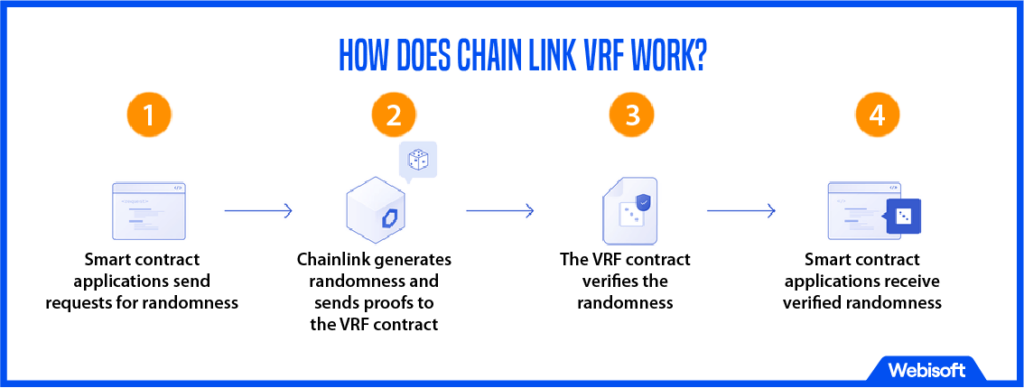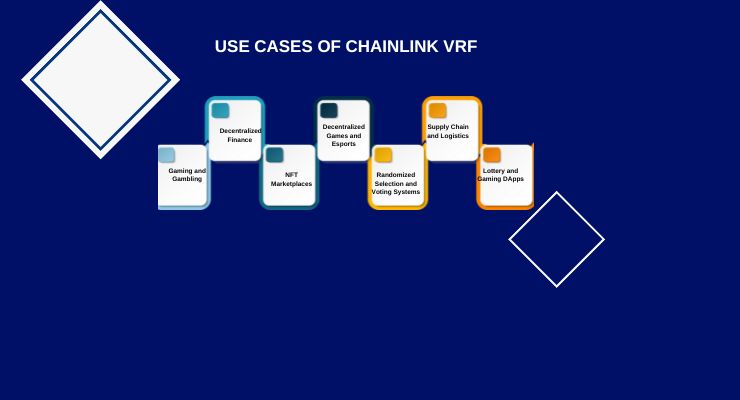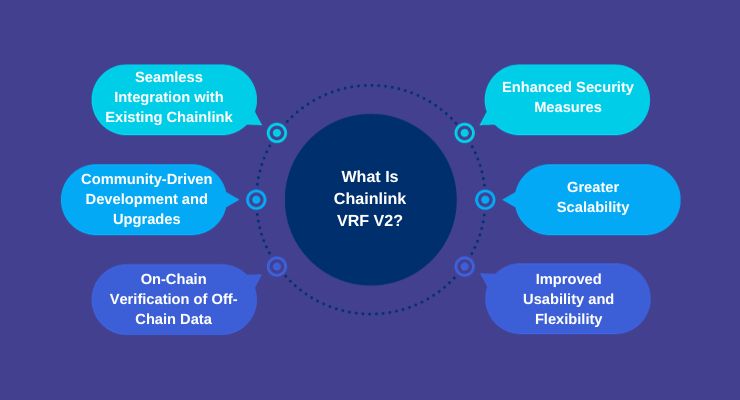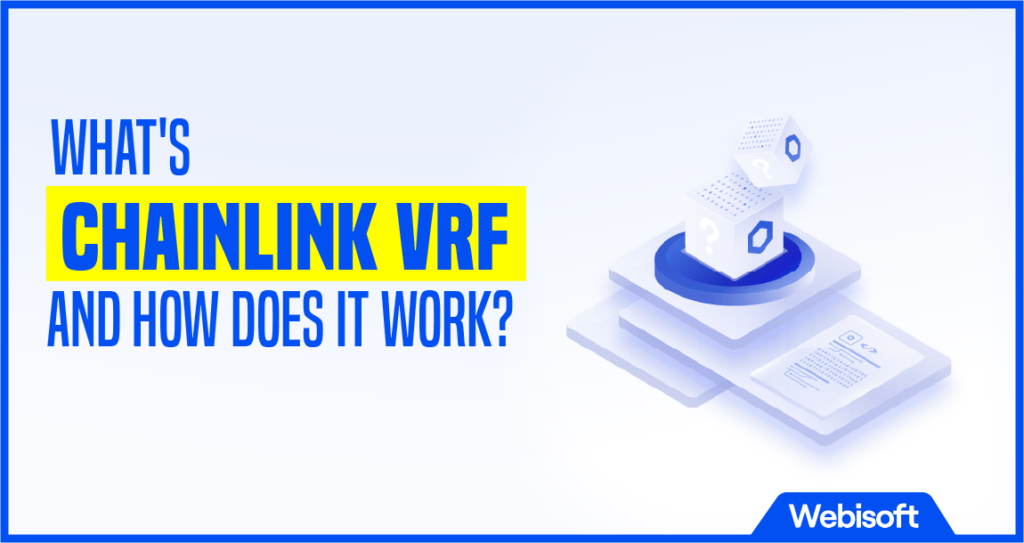In the world of blockchain technology, trust and security are paramount. When it comes to generating random numbers on the blockchain, traditional methods fall short of providing the necessary transparency and tamper-proof guarantees.
That’s where Chainlink VRF (Verifiable Random Function) steps in. Chainlink VRF is a cutting-edge solution that enables the generation of provably random numbers on a decentralized network.
In this article, we will delve into the intricacies of Chainlink VRF, exploring its inner workings and highlighting its benefits.
Contents
Threats From A Randomization Perspective
When it comes to randomization on the blockchain, there are several challenges and threats that need to be considered. In this section, we will explore these threats in more detail to understand why a robust solution like Chainlink VRF is necessary.
1. Centralized Vulnerabilities
One of the major concerns in random number generation is the potential for manipulation or bias when the process is centralized. Centralized solutions rely on a single point of failure, which introduces vulnerabilities.
If a single entity controls the randomization process, there is a risk of manipulation, whether intentional or due to external attacks. This lack of transparency and accountability undermines the integrity of applications that depend on random numbers.
2. Lack of Authenticity
Even if a random number is generated correctly, there may still be doubts regarding its authenticity and whether it has been tampered with.
Without a mechanism to verify the randomness of the generated numbers, users and applications must blindly trust the centralized authority responsible for the randomization process. This lack of verifiability introduces uncertainties and erodes confidence in the system.
3. Reproducibility and Predictability
True randomness requires unpredictability, but traditional random number generation methods may fall short of achieving this.
If a malicious actor can predict or reproduce the generated numbers. it undermines the fairness and security of applications. Predictable random numbers can be exploited for personal gains, such as manipulating game outcomes or unfairly distributing rewards in decentralized finance platforms.
4. Collusion and Sybil Attacks
In decentralized systems, collusion and Sybil attacks pose additional threats to random number generation. Collusion occurs when multiple participants work together to manipulate the outcome in their favour.
Similarly, Sybil’s attacks involve creating multiple fake identities to gain control or influence over the randomization process. These attacks can compromise the fairness and reliability of random number generation, leading to unfair advantages and financial losses for users.
5. Lack of Public Auditability
Transparency is a critical aspect of random number generation, particularly in applications where fairness and trust are paramount. Without the ability for external parties to audit the randomization process, doubts may arise regarding the integrity of the generated numbers.
Public audibility ensures that anyone can verify the randomness of the numbers, fostering trust and eliminating the need for blind reliance on centralized authorities.
By recognizing these threats, we can appreciate the importance of a decentralized and verifiable randomization solution like Chainlink VRF. In the next section, we will delve into what Chainlink VRF is and how it addresses these challenges effectively.
What Is Chainlink VRF?
Chainlink VRF, or Verifiable Random Function, is a key component in the Chainlink oracle network that enables the generation of provably random numbers on the blockchain. It addresses the limitations and threats associated with traditional random number generation methods by providing a secure and decentralized solution.
The need for verifiable randomness in decentralized environments is critical for various applications, such as gaming, gambling, decentralized finance (DeFi), and more. Chainlink VRF solves this problem by leveraging a combination of cryptographic techniques and decentralized oracle networks.
Chainlink VRF works through a two-step process: requesting a random number and generating verifiable randomness. When a smart contract or application requires a random number, it sends a request to the Chainlink VRF oracle.
The request includes parameters like a user-defined seed value to customize the random number generation process. The Chainlink VRF oracle receives the request and combines the user-provided seed value with other inputs, such as the current block hash and a secret key managed by the oracle node operators.
These inputs are used to compute the random number in a way that ensures its integrity and unpredictability. Once the random number is computed, it is returned to the requesting smart contract or application.
Crucially, along with the random number, the Chainlink VRF oracle provides cryptographic proof. This proof allows anyone to independently verify the authenticity and randomness of the generated number, ensuring it has not been tampered with or predicted.
Chainlink VRF offers several benefits, including transparency and verifiability. The cryptographic proofs accompanying the random numbers enable anyone to audit and verify their authenticity.
The decentralized nature of the Chainlink Oracle network enhances security and reliability, eliminating the risks associated with centralized solutions.
How Does Chain Link VRF Work?
Chainlink VRF, or Verifiable Random Function, utilizes a combination of cryptographic techniques and decentralized oracle networks to generate provably random numbers on the blockchain.
In this section, we will delve into the inner workings of Chainlink VRF and explore the steps involved in its operation.

Requesting a Random Number
The process begins when a smart contract or application requires a random number. It sends a request to the Chainlink VRF oracle network, specifically the Chainlink VRF oracle.
This request contains essential parameters that influence the random number generation, such as a user-defined seed value.
Verifiable Randomness Generation
Upon receiving the request, the Chainlink VRF oracle proceeds to generate the random number in a secure and verifiable manner. The generation process involves several key steps:
Step 1: Initialization
The Chainlink VRF oracle performs an initialization step to prepare for the randomness generation. This includes setting up the necessary cryptographic primitives and keys required for the computation.
Step 2: Combining Inputs
To ensure the unpredictability and integrity of the generated random number, the Chainlink VRF oracle combines various inputs. These inputs typically include:
- User-Defined Seed: The user-provided seed value adds a layer of customization and personalization to the random number generation process. It allows users to incorporate their own unique inputs, enhancing the randomness according to their specific requirements.
- Current Block Hash: The Chainlink VRF oracle incorporates the hash of the current blockchain block as an input.
By including this value, the randomness generation process becomes tied to the state of the blockchain at that specific point in time, further enhancing the security and integrity of the generated random number.
- Secret Key: The Chainlink VRF oracle utilizes a secret key managed by the oracle node operators.
This secret key is a critical component in the generation process, ensuring that the generated random number cannot be tampered with or predicted.
Step 3: Random Number Computation
Using the combined inputs, the Chainlink VRF oracle performs the computation to generate the random number. The specific algorithm employed for this computation depends on the cryptographic techniques and protocols implemented by Chainlink VRF.
It’s important to note that the computation process is deterministic, meaning that given the same inputs, the same random number will always be generated.
However, the key aspect lies in the fact that the inputs used are unpredictable, making it impossible to deduce or manipulate the random number without access to the secret key.
Step 4: Generating the Proof
Alongside the computed random number, the Chainlink VRF oracle generates a cryptographic proof known as a “proof verifiably demonstrating the integrity of the randomness.”
This proof is essential for ensuring the authenticity and verifiability of the generated random number.
The proof allows anyone to independently verify that the random number has been generated correctly and has not been tampered with or biased.
By verifying the proof, participants can trust the randomness generated by the Chainlink VRF oracle, eliminating the need for blind trust in a centralized authority.
Retrieving the Random Number
Once the random number and its accompanying proof have been computed, the Chainlink VRF oracle returns them to the requesting smart contract or application.
The random number can then be used within the application to determine outcomes, distribute rewards, or facilitate any other functionality that relies on verifiable randomness.
The availability of cryptographic proof enables participants to verify the authenticity and integrity of the random number independently. This transparency and verifiability contribute to the overall trustworthiness of the Chainlink VRF system.
In the subsequent sections, we will explore the benefits of using Chainlink VRF, the exact system requirements for its implementation, as well as various use cases that demonstrate its applicability in different
Why Should We Use Chainlink VRF?
Chainlink VRF, or Verifiable Random Function, offers numerous advantages and benefits that make it a compelling choice for applications requiring secure and provably random numbers on the blockchain.
In this section, we will explore the reasons why Chainlink VRF should be considered for your decentralized application.
Enhancing Security and Integrity
One of the primary reasons to use Chainlink VRF is its ability to enhance the security and integrity of random number generation.
Traditional random number generation methods are often vulnerable to manipulation, bias, or predictability, which can be exploited by malicious actors. Chainlink VRF mitigates these threats by providing cryptographic proofs that verify the authenticity and randomness of the generated numbers.
This ensures that the random numbers cannot be tampered with, providing a higher level of trust and security for applications.
Decentralization and Trustlessness
Chainlink VRF operates within a decentralized oracle network, leveraging the power of multiple independent nodes to generate random numbers. This decentralized approach eliminates the reliance on a single trusted entity or central authority.
And reducing the risk of manipulation or collusion. By leveraging the consensus of multiple Oracle nodes, Chainlink VRF ensures that the generated random numbers are not controlled by any single party, making it more trustworthy and resilient.
Transparency and Verifiability
Chainlink VRF brings transparency and verifiability to the random number generation process.
With the cryptographic proofs provided by the Chainlink VRF oracle, anyone can independently verify the authenticity and randomness of the generated numbers.
This transparency allows participants to audit and validate the randomness, building trust in the system and eliminating the need for blind trust in a centralized entity.
Customizability and Flexibility
Chainlink VRF offers a high degree of customizability and flexibility in the random number generation process.
Users can incorporate their own seed values into the computation, allowing them to tailor the randomness according to their specific application requirements.
This customization empowers developers to adapt the random number generation to different use cases, ensuring the generated numbers align with the desired outcomes.
Wide Range of Use Cases
Chainlink VRF is applicable to a wide range of use cases across various industries. Whether it’s gaming, gambling, decentralized finance (DeFi), supply chain management, or any other application that requires random number generation, Chainlink VRF provides a reliable and secure solution.
Its versatility and robustness make it a popular choice among developers and businesses seeking trustworthy randomness on the blockchain.
Integration with Existing Blockchain Infrastructure
Chainlink VRF is designed to seamlessly integrate with existing blockchain infrastructure. It can be easily incorporated into smart contracts and decentralized applications, leveraging the power of the Chainlink oracle network.
The integration process is well-documented and supported, making it accessible to developers regardless of their level of expertise.
In conclusion, Chainlink VRF offers a secure, decentralized, and verifiable solution for generating random numbers on the blockchain.
With its enhanced security, transparency, and flexibility, it is well-suited for a wide range of applications. By leveraging Chainlink VRF, developers and businesses can ensure the integrity and trustworthiness of their random number generation processes, providing a solid foundation for their decentralized applications.
What Are the Exact System Requirements for Chainlink VRF?
To effectively integrate and utilize Chainlink VRF (Verifiable Random Function) within your application or smart contract, it’s essential to understand the system requirements and dependencies.
In this section, we will explore the specific requirements for incorporating Chainlink VRF into your project.
Supported Blockchain Platforms
Chainlink VRF is designed to be blockchain-agnostic, which means it can be integrated with various blockchain platforms. Currently, Chainlink VRF is compatible with the following blockchain networks:
- Ethereum
- Binance Smart Chain
- Polygon (formerly Matic)
- Avalanche
- Fantom
- xDai
- Huobi ECO Chain
- Harmony
- Near Protocol
- OKEx Chain
- ICON
Before integrating Chainlink VRF, ensure that your chosen blockchain platform is supported and compatible with Chainlink’s Oracle infrastructure.
Smart Contract Language
To interact with Chainlink VRF, you’ll need to write or modify your smart contract code using a supported programming language. Chainlink VRF supports multiple languages, including:
- Solidity: The most commonly used language for Ethereum-based smart contracts.
- Vyper: Another Ethereum-specific language known for its focus on security.
- Chainlink Node.js: Allows integration with Chainlink VRF using JavaScript. Make sure your development environment supports one of these languages before proceeding with the integration.
Chainlink Node
To access Chainlink VRF services, you’ll need to connect to a Chainlink node or utilize a third-party service that interacts with Chainlink’s oracle network.
Setting up and running a Chainlink node requires some technical expertise and infrastructure. However, you can also leverage third-party providers that offer access to Chainlink’s oracle services.
Access to External Data
Since Chainlink VRF relies on external data to generate random numbers, your application or smart contract should have access to relevant data sources.
Chainlink uses oracles to fetch real-world data, which is then used as input to generate random numbers. Ensure that your system has a reliable and secure connection to Chainlink’s Oracle network or other trusted data sources.
Sufficient Gas or Transaction Fees
When using Chainlink VRF on blockchain platforms like Ethereum, it’s important to consider the gas or transaction fees associated with your transactions.
Generating random numbers using Chainlink VRF requires submitting transactions to the blockchain. And each transaction incurs a cost. Make sure you have a sufficient supply of the native cryptocurrency of your chosen blockchain platform to cover these fees.
Developer Knowledge and Resources
Lastly, to successfully integrate Chainlink VRF, you or your development team should possess a solid understanding of smart contract development, blockchain platforms, and Chainlink’s Oracle infrastructure.
Familiarize yourself with the Chainlink documentation, guides, and resources available to developers. This will enable you to make informed decisions and effectively implement Chainlink VRF within your project.
In conclusion, integrating Chainlink VRF into your application or smart contract requires support for the specific blockchain platform. And knowledge of compatible smart contract languages, access to Chainlink’s oracle network or third-party services, and an understanding of gas fees and transaction costs.
By meeting these system requirements, you can leverage Chainlink VRF’s capabilities to enhance the randomness and security of your decentralized applications.
Use Cases of Chainlink VRF

Chainlink VRF (Verifiable Random Function) offers a wide range of use cases across various industries and applications. Its secure and transparent random number generation capabilities make it a valuable tool for ensuring fairness, security, and trust in decentralized systems.
Let’s explore some of the prominent use cases where Chainlink VRF can be effectively applied.
1. Gaming and Gambling
In the gaming and gambling industry, fairness and randomness are of utmost importance. Chainlink VRF enables provably fair gaming by providing verifiably random numbers for processes such as determining winners, shuffling decks, or generating unpredictable game elements.
By integrating Chainlink VRF, gaming platforms, online casinos, and blockchain-based gambling applications can ensure transparent and tamper-proof random outcomes, enhancing user trust and engagement.
2. Decentralized Finance (DeFi)
Decentralized Finance, or DeFi, has emerged as a prominent use case for blockchain technology. Chainlink VRF plays a vital role in DeFi applications by generating random numbers for various processes, such as determining interest rates, distributing rewards, conducting lotteries, or facilitating on-chain options contracts.
With Chainlink VRF, DeFi protocols can introduce an element of unpredictability and fairness, reducing the risk of manipulation and enhancing the overall security of financial transactions.
3. NFT Marketplaces
Non-Fungible Tokens (NFTs) have gained significant popularity, revolutionizing the world of digital collectables, art, and unique assets.
Chainlink VRF can be used in NFT marketplaces to introduce randomness and scarcity. For example, it can be employed to determine the rarity of NFT attributes, randomize the order of drops or auctions, or select winners for limited edition NFTs.
By incorporating Chainlink VRF, NFT platforms can ensure fairness and create an engaging and unpredictable user experience.
4. Decentralized Games and Esports
Decentralized games and esports platforms can greatly benefit from Chainlink VRF’s random number generation capabilities. By leveraging Chainlink VRF, game developers can introduce randomness into gameplay, including loot drops, enemy encounters, or procedurally generated game elements.
This enhances the replayability and excitement of games while ensuring a fair and transparent experience for all participants.
5. Randomized Selection and Voting Systems
Chainlink VRF can be utilized in various selection and voting systems that require verifiably random and unbiased outcomes. Whether it’s conducting random giveaways, selecting jury members, or facilitating fair voting mechanisms, Chainlink VRF provides a reliable and tamper-resistant source of randomness.
By integrating Chainlink VRF, organizations can enhance the integrity and transparency of their selection processes, fostering trust and credibility among participants.
6. Supply Chain and Logistics
Supply chain and logistics processes often involve multiple stakeholders and require trustworthy randomization for tasks such as selecting shipping routes, scheduling deliveries, or optimizing resource allocation.
By incorporating Chainlink VRF, supply chain and logistics platforms can introduce transparency and fairness into their operations, ensuring equitable distribution and efficient decision-making based on verifiable random inputs.
7. Lottery and Gaming DApps
Lottery and gaming decentralized applications (DApps) rely on unbiased and secure random number generation. Chainlink VRF offers a reliable solution for such applications by providing verifiable randomness.
By utilizing Chainlink VRF, lottery platforms and gaming DApps can guarantee fair outcomes, eliminating the risk of manipulation and enhancing user confidence and engagement.
These are just a few examples of the many potential use cases for Chainlink VRF. Its versatility and security make it a valuable tool across industries, ensuring transparent and tamper-proof random number generation. By integrating Chainlink VRF, developers and businesses can enhance the integrity,
What Is Chainlink VRF V2?
Chainlink VRF (Verifiable Random Function) v2 is the latest version of Chainlink’s secure and decentralized random number generation solution.
Building upon the success and robustness of the original Chainlink VRF, version 2 introduces several enhancements and features to further improve the reliability, scalability, and usability of the system.

1. Enhanced Security Measures
Chainlink VRF v2 incorporates advanced security measures to ensure the integrity and authenticity of generated random numbers.
It utilizes cryptographic primitives and techniques such as zero-knowledge proofs and threshold signatures to enhance the verifiability and trustworthiness of the generated randomness.
These security measures make Chainlink VRF v2 highly resistant to manipulation and collusion attempts.
2. Greater Scalability
Scalability is a critical factor in blockchain systems, especially as adoption increases. Chainlink VRF v2 addresses scalability challenges by leveraging off-chain aggregation.
This allows multiple off-chain computations to be aggregated into a single on-chain proof, reducing the on-chain footprint and improving efficiency.
As a result, Chainlink VRF v2 can handle a larger volume of random number generation requests without compromising performance or increasing gas costs.
3. Improved Usability and Flexibility
Chainlink VRF v2 introduces enhancements to its interface and usability, making it more developer-friendly and versatile. It offers expanded parameter options, allowing developers to customize the random number generation process to better suit their specific needs.
The updated interface also simplifies the integration process, enabling developers to seamlessly incorporate Chainlink VRF v2 into their applications and smart contracts.
4. On-Chain Verification of Off-Chain Data
One notable feature of Chainlink VRF v2 is the ability to verify the authenticity and integrity of off-chain data used in the random number generation process. This is achieved through the inclusion of cryptographic proofs that enable on-chain verification of the off-chain computations.
By providing verifiability of the entire process, Chainlink VRF v2 ensures transparency and trust in the random number generation mechanism.
5. Community-Driven Development and Upgrades
Chainlink VRF v2 is developed in collaboration with the Chainlink community and benefits from continuous community-driven feedback and improvements. This community involvement ensures that the solution evolves to meet the specific needs and requirements of the users.
Through an open and collaborative development process, Chainlink VRF v2 is constantly enhanced, providing developers with a cutting-edge and reliable random number generation tool.
6. Seamless Integration with Existing Chainlink Infrastructure
Chainlink VRF v2 is designed to seamlessly integrate with the existing Chainlink Oracle infrastructure. This compatibility allows developers to leverage the extensive capabilities of Chainlink oracles and access reliable, verifiable random numbers through Chainlink VRF v2.
The integration enables the combination of various decentralized services and functionalities, empowering developers to build robust and secure applications.
Chainlink VRF v2 represents a significant advancement in decentralized random number generation. With enhanced security measures, improved scalability, and increased usability, Chainlink VRF v2 offers a powerful and versatile solution for ensuring fairness, transparency, and trust in decentralized systems.
By adopting Chainlink VRF v2, developers can unlock new possibilities in various industries and applications, contributing to the growth and innovation of the blockchain ecosystem.
Conclusion
In conclusion, Chainlink VRF is a groundbreaking technology that revolutionizes random number generation in decentralized applications.
It addresses the threats associated with inadequate randomization and provides a secure and verifiable solution. Chainlink VRF offers numerous benefits, including provably fair gaming, unbiased rewards, and secure smart contract operations.
By meeting the specific system requirements and integrating Chainlink VRF into their applications, developers can ensure transparency, trust, and fairness. With the introduction of Chainlink VRF v2, the technology continues to evolve and enhance its security and scalability.
Embracing Chainlink VRF empowers developers to create decentralized applications that rely on reliable randomness, driving innovation and user confidence in the blockchain industry.
Get in touch with our expert contract developers if you want to learn more about the Chainlink VRF and how it works in practice.
